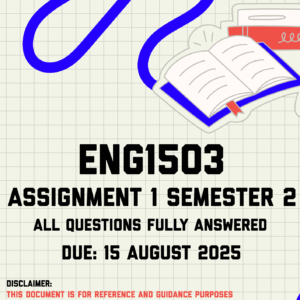Description
MIP2602 Assignment 4 Memo | Due 15 August 2025. Step by Step Calculations provided.
SECTION A: PROBABILITY
QUESTION 1
1.1 A bag contains a total of 10 marbles: 3 red marbles, 4 blue marbles, 2 green marbles, and 1 yellow marble……….
MIP2602 Assignment 4 Memo | Due 15 August 2025. Step by Step Calculations provided.
SECTION A: PROBABILITY
QUESTION 1
1.1 A bag contains a total of 10 marbles: 3 red marbles, 4 blue marbles, 2 green marbles, and 1 yellow marble……….
Only logged in customers who have purchased this product may leave a review.






MIP2602 Assignment 4 Memo | Due 15 August 2025. Step by Step Calculations provided.
SECTION A: PROBABILITY
QUESTION 1
1.1 A bag contains a total of 10 marbles: 3 red marbles, 4 blue marbles, 2 green marbles, and 1 yellow marble……….
There are no reviews yet.
Only logged in customers who have purchased this product may leave a review.
pretanik
Anne Moore
Jules Law Tutor
Mbali Law Tutor
Mbali Law Tutor
Mbali Law Tutor
Andre
Andre
Andre
SHINING SMILE ACADEMY
SHINING SMILE ACADEMY
The Graduate
Reviews
There are no reviews yet.